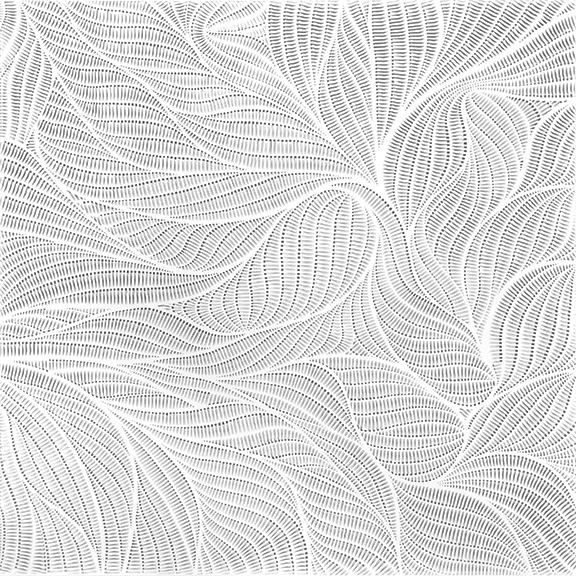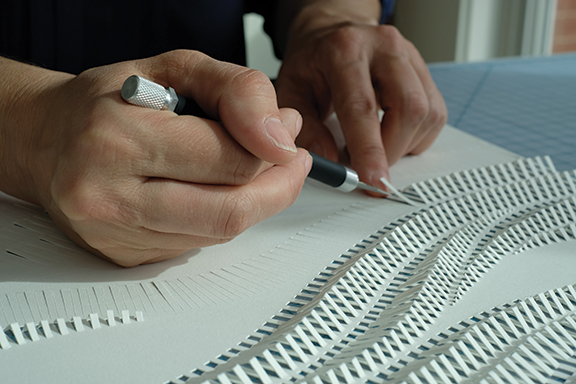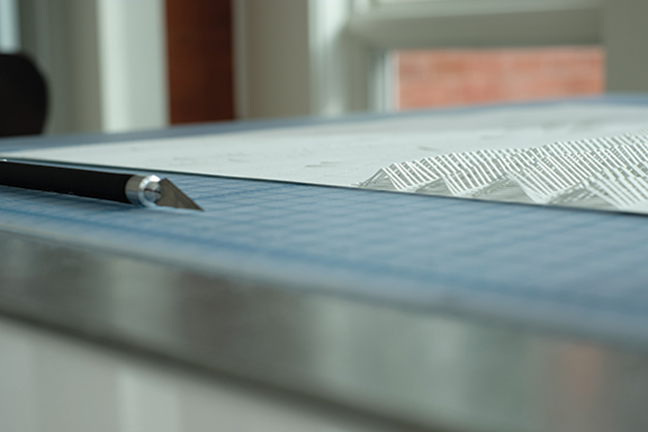BY SHALEEN DESTEFANO
I’ll be honest, when I first heard that there was a paper artist who lived in Wash Park, I made the wildly false assumption that we were talking about origami. Instead, when Rachel welcomed me into her studio I stood astonished at the scale and precision of her art. I had so many questions and she, not unlike the beautiful calm of her work, was patient and more than welcome to show me how she crafts these paper reliefs.
 Rachel, let’s start at the beginning of your story. Tell us how you made the switch from architect to fine artist.
Rachel, let’s start at the beginning of your story. Tell us how you made the switch from architect to fine artist.
My art practice is really an extension of my architectural practice and is rooted in several architectural ideas and habits. I am working with light, space and materiality just as an architect would, but at a smaller scale.
I actually started making work very similar to what I’m making today in my first year of architecture study. I became very interested in the architectural theorist Stan Allen’s articulation of the term “field.” The basic idea is that there is an alternative to the classic opposing relationship of figure and ground, which can be simply understood as a figure drawn against a background. In a field, figure is not an object read against a background, but is instead an effect emerging from the field itself. My paper reliefs play with this idea directly, even at a material level.
Another feature of my work that stems from my architectural background is efficient use of material. My work generates no waste. Every bit of the original piece of paper remains in its place, only slightly lifted or lowered to create plays of light depth, and shadows.
Was it your familiarity with paper that led you to that medium? Tell us about how you landed on this technique.
I first started working with the dimensional qualities of paper when I was in architecture school because it was cheap and easy to work with. Most of my projects started with me cutting, folding and manipulating a sheet of paper until I saw an idea emerge. I got very comfortable working with the material and handling a knife. I began to think through the process of making, which remains important in my work.
 Your paper reliefs are stunning and the depth of detail becomes apparent when you get up close to your pieces. How long does a larger scale piece take you?
Your paper reliefs are stunning and the depth of detail becomes apparent when you get up close to your pieces. How long does a larger scale piece take you?
Because all my work is made by hand, it does take a long time to finish. Large scale pieces can take up to two months to complete.
Watching you work is meditative and calming. Is the same true for you?
The word “relief” refers to two different concepts in English, but both meanings originated in the Latin word relevare “to raise, lighten.” In art, the term refers to a sculptural technique where the sculpted material is raised or lowered from background plane. This is descriptive of the process I use to make my art but that process itself invokes the other meaning of relief, in that the meditative quality of my work is precisely what makes space for the patience and discipline required to complete the work.
The evidence of the process is the visibility of my hand in the work. Slight imperfections give the work a human quality, and the apparent slow pace stands in sharp contrast to the frenetic world we live in today.
People will often stand in front of my art for a long time, their gaze moving along the flow of the surface, suspended in a temporary meditative state of concentration.
 Your work can resemble a topography map or shapes of leaves. Where do you find your inspiration for your designs?
Your work can resemble a topography map or shapes of leaves. Where do you find your inspiration for your designs?
I’m always interested in what people see in my work. I think each person’s own experiences and memories shape what they see. In this way, the work is always changing based on the viewer.
Each piece is an invented and abstracted landscape based loosely on what’s swirling around in my head. I travel extensively, follow other artists’ and architects’ work, and spend much of my free time outside studying the forms of nature. I rarely reference images as I work, with a notable exception being the Boulder Flood piece I made last year for the “Art of Data” show in Boulder.
Tell us about “Art of Data” and how that piece came to be.
“Art of Data” was a show put on by the City of Boulder, where artists were invited to make artwork based on City Data. This challenge was interesting to me because it would bring me back to some of the more concrete representational ideas that were present in my work when I was in school, but also was interesting on a personal front. Both of my parents are water engineers and I knew I wanted to make a piece for the five year anniversary of the Boulder Flood, certainly one of the most significant events in the city’s history. Even though the piece is based on Data, the nature of my process makes the piece extend beyond simple representation.
The thriving Denver art scene is warm and inviting. Which local artists are you most inspired by?
One of the things I love most about living in Denver is how approachable the art world is. This was so important for me as I shifted over from an adjacent field and needed to find my way. Colin Parson at the Arvada Center is a wonderful artist, but also a great curator. He gave me one of my first opportunities to show my work in the Denver area. I have loved watching Jonathan Saiz and appreciate his interesting and generous approach to making art accessible. I’m looking forward to his upcoming show at the Denver Art Museum. I love the materiality of Erica Green’s work and think we have a lot in common in our approach to making art. And I’d be remiss not to mention Sammy Lee, another architect turned paper artist who makes wonderful paper relief sculptures, very different from my own, using a traditional Korean technique called joomchi.
Where can we see your work?
I am collaborating with another artist, Jessica Loving, on a piece for the Pink Progression Show that will be at the Arvada Center this summer. I also have work available locally through Rule Gallery. The best way to keep up with what I’m up to and to follow along with me in my studio is to follow me on Instagram @racheldoniger.
I am grateful to have met you, Rachel, and so thrilled to have had the opportunity to share your art with our readers. Please visit www.racheldoniger.com for more information.

